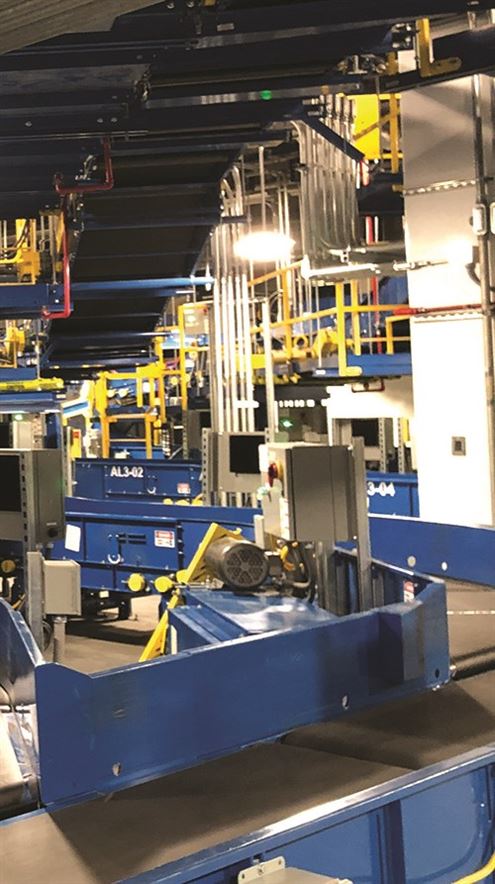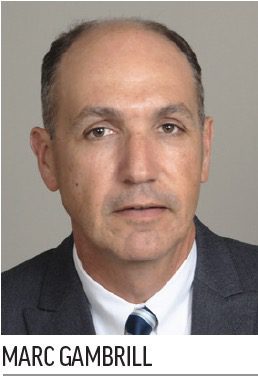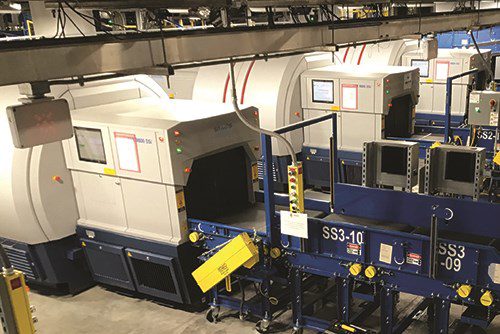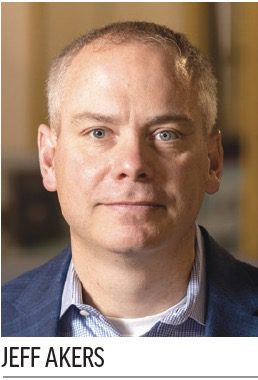When the Broward County Aviation Department rolled up its collective sleeves to replace the checked baggage inspection system in Terminal 4 at Fort Lauderdale-Hollywood International Airport (FLL), the team had a wealth of experience on its side. The department had replaced similar systems in FLL’s three other terminals over the past decade.
Albert Einstein is credited with saying, “The only source of knowledge is experience.”
Julius Caesar reportedly said, “Experience is the teacher of all things.”
And Aldous Huxley said, “Experience teaches only the teachable.”
When the Broward County Aviation Department rolled up its collective sleeves to replace the checked baggage inspection system in Terminal 4 at Fort Lauderdale-Hollywood International Airport (FLL), the team had a wealth of experience on its side. The department had replaced similar systems in FLL’s three other terminals over the past decade.
 facts&figures facts&figures
Project: Checked Baggage Inspection System Location: Fort Lauderdale-Hollywood Int’l Airport Terminal: 4 Cost: $38.2 million Funding: TSA; passenger facility charges Construction: April 1, 2019–Jan. 29, 2021 Project Lead: Broward County Aviation Dept. Design Criteria: Gresham Smith Design Builder/General Contractor: Whiting-Turner Contracting Company Prime Consultant, Structural & Mechanical, Plumbing, Fire Protection Engineer: GRAEF Electrical Engineer: Gartek Engineering Corp. Architect: ACAI Associates Inc. Baggage Handling System Engineer: VTC Baggage Handling System Mfg.: Jervis B. Webb Company Program Manager: AECOM Owner’s Rep: Turner Construction Company Explosives Detection System: 4 CTX 9800 machines from Smiths Detection Baggage Handling System Controls: Brock Solutions |
In addition, Whiting-Turner won the design-build contract through the Broward County solicitation procurement process, and it previously completed new baggage systems in terminals 1 and 3. As such, it brought a lot of institutional knowledge that would be beneficial to the design and building of the new baggage system at Terminal 4.
In effect, the band was back together. And the players tapped into their shared history of what worked (and didn’t) during the past projects to keep the $38.2 million Terminal 4 project on budget and on time. Construction began in April 2019, and the new system came online in January 2021. TSA covered the cost of new explosives detection system machines; the airport used funds from passenger facility charges to pay for the new baggage conveyor system.
“Having a contractor that has already been through it was a big benefit to us from a project standpoint,” says Curtis Celestine, expansion project administrator for the Broward County Aviation Department. “The working relationship is a big part of it.”
Some things, however, were different this time around. During previous projects, the primary airline using each respective terminal served as the project lead. For the Terminal 4 project, the Aviation Department took the lead. The airlines were involved at the outset of system planning and design development, via communication with the Airline Liaison Office and weekly stakeholder coordination meetings established by the Broward County Aviation Department. Spirit Airlines is the primary user of Terminal 4.
Creating Space
Like the previous replacement efforts, the Terminal 4 project followed a design-build format. This streamlined approach allowed the team to build the new checked baggage inspection system on top of the existing one, which was located in a tight space and had to continue operating at its regular hurried pace. Celestine refers to the strategy as “creating space within a space.”
 The new checked baggage inspection system that was installed meets TSA’s latest Planning Design Guidelines Standards (PDGS), which require air-conditioning and minimize manual lifting for inspection personnel. Preliminary planning and design work involved months of coordination and review by airport stakeholders to define the final configuration. The system that resulted leverages in-line explosives detection machines and integrates with existing induction lines and make-up units. Celestine notes that due to the age of the previous system, there was no realistic opportunity to enhance it to current TSA design standards.
The new checked baggage inspection system that was installed meets TSA’s latest Planning Design Guidelines Standards (PDGS), which require air-conditioning and minimize manual lifting for inspection personnel. Preliminary planning and design work involved months of coordination and review by airport stakeholders to define the final configuration. The system that resulted leverages in-line explosives detection machines and integrates with existing induction lines and make-up units. Celestine notes that due to the age of the previous system, there was no realistic opportunity to enhance it to current TSA design standards.
The new system works with the terminal’s existing ticket counter and curbside inputs and includes four CTX 9800 explosives detection machines from Smiths Detection. Each is designed to screen up to 640 bags per hour. Baggage is fed from existing input lines into the new system for screening, and pieces that clear levels 1 and 2 are routed to existing make-up units. Baggage requiring level 3 screening is routed to the new checked baggage resolution area, which includes 21 workstations.

The previous system required TSA employees to lift each checked bag at least twice. With the new automated system, they only physically handle checked bags when images cannot be resolved and bags are diverted to a physical search room.
The new speedier baggage screening system will help the airport accommodate passenger growth. FLL’s total passenger count increased from 29.2 million in 2016 to 36.7 million passengers in 2019.
 To maintain operations in Terminal 4, the project team phased the demolition of existing equipment and installation of new. “You still have to operate an airport and keep bags moving,” remarks Marc Gambrill, Chief Development Officer for the Broward County Aviation Department. “You do a piece of it, and then cut over.”
To maintain operations in Terminal 4, the project team phased the demolition of existing equipment and installation of new. “You still have to operate an airport and keep bags moving,” remarks Marc Gambrill, Chief Development Officer for the Broward County Aviation Department. “You do a piece of it, and then cut over.”
As with many projects underway in 2020, the global coronavirus pandemic affected this one. A number of individuals from the construction team contracted COVID-19, which prompted stricter protocols and caused some delays to the original schedule. On the positive side, lower passenger traffic due to the pandemic allowed contractors more flexibility regarding when and how long they worked. It also allowed them to dismantle the old system in larger pieces.

Better Technology
Personnel from VTC, system engineer for the Terminal 4 project, note that the new automated configuration actually screens more bags with four machines than the previous system did with six. Jeff Akers, a project manager with the firm, chalks it up to improved technology and points out that the new system actually has one more screening machine than it needs. The strategy was to design the system to meet the terminal’s current capacity and include one extra machine for expected growth, Akers explains.
 Technology was also addressed during an important enabling project, when Broward County Aviation Department worked with Brock Solutions to create a geo-redundant server environment. The improved design includes three server farms, with redundant fiber, that are strategically located at separate sites throughout the airport campus. The network is designed so that any one server can run all of the airport’s baggage handling systems while the other two are in standby mode. This means that FLL could lose up to two servers and still remain operational in all terminals. The new system in Terminal 4 was the first to cut over to this new architecture.
Technology was also addressed during an important enabling project, when Broward County Aviation Department worked with Brock Solutions to create a geo-redundant server environment. The improved design includes three server farms, with redundant fiber, that are strategically located at separate sites throughout the airport campus. The network is designed so that any one server can run all of the airport’s baggage handling systems while the other two are in standby mode. This means that FLL could lose up to two servers and still remain operational in all terminals. The new system in Terminal 4 was the first to cut over to this new architecture.
Celestine notes that a redundant server and network system by Brock Solutions will allow FLL to effectively consolidate operations across the entire campus. Now, a single application can operate all of the baggage handling systems and maintain, troubleshoot and manipulate conveyors, sortation destinations and flight schedules. If desired, a single report run can show data across all airlines. Administrators from Broward County are given full access to all report data; individual stakeholders and airlines only have access to their specific data.
Before construction of the new baggage system began, the project team used a 3-D scan of the existing facility to help identify potential utility conflicts. Scott Hinrichs, vice president/principal at GRAEF, notes that this was a strategy the engineering, planning and design firm carried over from its work on the Terminal 3 project.
 “We learned a lot of lessons in terms of being able to anticipate utility conflicts and be prepared with solutions as opposed to just letting them happen,” Hinrichs explains. “We were able to merge the scan into our 3-D building information model so we could run clash-detection programs to find interferences between proposed conveyors and utilities with existing infrastructure and utilities,” he explains.
“We learned a lot of lessons in terms of being able to anticipate utility conflicts and be prepared with solutions as opposed to just letting them happen,” Hinrichs explains. “We were able to merge the scan into our 3-D building information model so we could run clash-detection programs to find interferences between proposed conveyors and utilities with existing infrastructure and utilities,” he explains.
Another technology enhancement added during the project is a real-time, interactive graphic representation of the baggage handling system developed and operated by Brock Solutions. This live map shows all baggage in the system at any given moment. Individual bags can be identified by their air carrier, security status relative to their departure, or their sort destination.
Mark Gale, chief executive officer/director of aviation for Broward County Aviation Department, draws a straight line between the system improvements and passenger service. “The baggage handling and screening equipment upgrades we’re making at FLL improve operational efficiencies for our airline partners, such as increasing the speed and ease of bag processing and adding advanced security layers. These enhancements, in turn, provide customer service benefits in the long run,” Gale explains. “Our overall goal with ongoing terminal modernization efforts is to provide the best possible airport experience for passengers traveling through FLL.”



